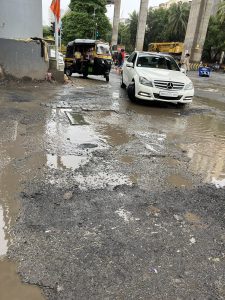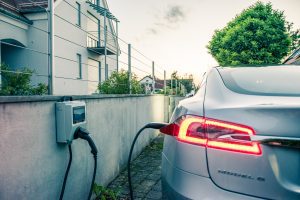Fires have been traced to manufacturers who tried integrating battery management systems rather than buying completely built units.

The Ruby hotel fire in Secunderabad started in the electric bike showroom in the basement (Supplied)
The Secunderabad hotel tragedy in which eight were killed after a fire broke out in an electric bike showroom below the lodge, has put the spotlight again on e-vehicles.
The national ambition is to have electric scooters and bikes make up 80 percent of the overall two-wheeler market. While the reason why the fire broke out in the Secunderabad showroom is not clear yet, incidents of electric vehicles going up in flames and even causing deaths can lead to lack of trust.
The government had earlier set up a committee to investigate the root cause of the fires and the preliminary findings pointed at battery cells and pack design in all e-vehicle fire incidents till then.
The instances of e-scooters catching fire have come as a surprise for many in the sector as most of the manufacturing firms involved have good technical teams that include alumni from India’s top institutions.
Battery expertise is, however, a new skill and there is very little deep experience in the country.
The electric vehicle is a new technology and its most important, performance-defining component is the battery.
The EV battery pack has five essential components — cathode, anode, separator, electrolyte, and a battery management system (BMS). The BMS is an integral part of the battery. Without it, there is no battery.
EV batteries work by discharging lithium ions from the anode to the cathode through the electrolyte. Most lithium-ion batteries use anodes made of graphite, which are typically layers of carbon sheets. The space between the carbon layers becomes the perfect location to receive lithium ions as the battery charges, and release them as it discharges.
The battery’s capacity is defined by the maximum amount of lithium that can be collected on the anode. This capacity determines the distance an EV can travel before it needs to be charged again.
All this information and other factors related to the health of the battery are controlled by the BMS. The integration of the BMS with the battery cells and the vehicle environment it operates in is crucial. The fires have been traced back to manufacturers who tried integrating rather than buying completely built units.
That nearly 90 percent of fires in lithium-ion batteries are caused by an internal short circuit shows a failure in the battery pack to manage its components.
Within the battery cell, the graphite anode forms a layer called the solid electrolyte interface (SEI) to protect the graphite from reacting with the electrolyte, which is usually a lithium salt such as Lithium hexafluorophosphate in organic carbonates — such as mixtures of ethylene carbonate with dimethyl carbonate, propylene carbonate, diethyl carbonate, and/or ethyl methyl carbonate.

Potholes in one of Bengaluru’s busy roads (Supplied)
This is a volatile substance that is flammable at high temperatures. A severe external force to the battery such as a crash can rupture the cell wall and lead to electrolyte leakage, causing a fire at very high temperatures.
Indian roads are often uneven and can potentially harm a battery with manufacturing defects.
A cell could be compromised due to mechanical vibration if the vehicle is moving on an uneven road, causing the displacement of a connector. It could also break a thin separator and lead to a rise in temperature that, in turn, affects the SEI and melts the polymer. This releases the electrolyte to cause a fire.
An irregular SEI, if broken, could expose the graphite to the electrolyte leading to a “thermal event”. The formation of the anode material is therefore important for a uniform SEI layer to be formed so as to ensure smooth movement of ions.
Spontaneous combustion in the e-scooters could have been caused by dendrites — thin, hair-like structures created on the anode due to overcharging.
The electrode manufacturer may have added extra material to cram more energy in the same amount of space and opted for a thinner separator. As a result, dendrites could break through the separator and cause a fire.
This is believed to be one of the factors behind cell phone explosions that occurred sometime earlier.
Eight killed and at least 10 others injured in a major fire that broke out in an electric bike showroom in #Secunderabad
All the dead were guests in the Ruby hotel above the building pic.twitter.com/joGbVB1bjC
— South First (@TheSouthfirst) September 13, 2022
Such an event is expected to be managed by the battery management system, which stops charging at an optimum point (about 80 percent).
Most of the recent events can be managed by an efficient BMS. However, if the BMS is compromised, it cannot offer optimum communication with the battery cells as well as the owner.
The EV battery cells or the BMS are not made in India. Some firms assemble the BMS with imported components while others buy them off the shelf and integrate them with battery cells.
The manufacturers claim that the prototypes of the e-two wheelers involved in fire incidents were tested adequately, and that they are looking into the BMS black box data for answers.

A Tesla Model S electric car gets charged (Wikimedia Commons)
Most electric four-wheelers are armed with an active thermal management system with liquid cooling of the battery.
They are also passive cooling methods with phase change material (PCM), a wax-like substance that melts when the temperature rises in the cell and can act as a buffer against a fire. Tesla has a 2012 patent on such a fire-retardant material.
Another method uses aluminium foam within the PCM to arrest a fire. A combination of active and passive cooling systems offers electric four-wheelers a more efficient method to avoid fires.
Electric scooters have a space constraint within the battery cavity and cannot accommodate an active cooling system.
The standard brief to the engineering department assembling batteries is to focus on cost and mileage — or range — along with safety. The second parameter is addressed with the battery chemistry.
Indian manufacturers work with two battery cathode chemistries — lithium nickel manganese cobalt oxide (NMC) and lithium iron phosphate (LFP). Manufacturers prefer NMC cathode-based battery cells as they offer 20-30 percent higher range.
LFP is safer than NMC and costs less too. Considering the damage caused by the fires, LFP could serve as an interim solution for scooters that cannot accommodate a thermal management system.
As scooters are mostly used for neighbourhood mobility, relatively lower energy density could be a trade-off till there are safer technologies.
Clearly, it is not possible to test all batteries. Only a few get tested before the manufacturer decides to buy a batch.
According to manufacturers whose products have been involved in the fires, their batteries meet the AIS 156 safety standards that cover L category vehicles. The L category includes two- and three-wheelers and quadricycles.
The AIS 156 standards, which was prepared in September 2020 based on the UN 136 regulations, does not mention BMS in the entire document. However, it takes a system-level approach and covers both vehicle electrical safety and Rechargeable Electrical Energy Storage System (REEES) safety.
Though it covers overcharge, over-discharge as well as increase in temperature and fires originating in a battery, adherence to the standards has not worked for the manufacturers involved.
Indian manufacturing companies could look at importing battery engineering skills from countries with long-term experience in battery manufacturing the way the US had in 2011 and 2012. After the US Department of Energy handed out hefty grants to several battery companies to build EV batteries, companies brought in personnel from Korea and Japan to build R&D teams.
Are lithium-ion batteries unsuited for Indian climate conditions? External temperatures do not have a direct impact on a lithium-ion cell’s health, but the Li-ion cell is known to operate best between 20 and 40 degrees Celsius.

Summers can be extremely hot in India, with temperatures in many parts of the country crossing 40 degrees Celsius (Prasanna RS/South First)
In case of a hot spot within the battery, when the temperature inside increases beyond the temperature outside, the external temperature does not really help with containing it, even though this would be a passive impact.
When the electrolyte heats up and starts evaporating and the cathode provides oxygen, and the two together build huge pressure within the cell — things have already reached a point of no return. The key, therefore, lies in prevention.
Apart from fires, some e-scooters have been malfunctioning, especially with the reverse function. These events will likely increase premiums as insurance companies reassess the risk of the new products.
While the loss of life and injuries due to accidents are covered under the existing insurance plans, new plans have to be drawn up to cover manufacturing defects. The current insurance plans do not cover that and the liability for payment of claim in such a case falls on the manufacturer.
In addition, a personal accident cover that is mandated by law is optional in an EV insurance policy. The policy covers the owner-driver during mounting, dismounting and driving the vehicle, and a co-driver who is travelling with the owner-driver. The absence of a compulsory accident cover leaves e-scooter users vulnerable to several risks.
A number of e-scooter manufacturers, including Okinawa and Ola, have recalled the defective vehicles to run advanced diagnostics on their batteries’ thermal and safety systems.
The e-scooter fires have underlined the need for strict manufacturing regulation.
At the policy level, the government could offer licences to a select few players to assemble and manufacture battery packs, as in the case of LPG gas cylinders.
Only a few players are allowed to manufacture and sell gas cylinders and regulators, and they follow the required standards. The regulator on the cylinder can be compared with a BMS that controls the battery.
Even China had a limited list of companies that were approved by the Chinese Ministry of Industry and Information Technology (MIIT) in 2015 — in what was called a “white list” — to supply batteries to original equipment manufacturers (OEMs). Some of the names on that list are now global battery majors: BYD and CATL.
Building a battery manufacturers club would ensure access to capital for R&D so that EV battery fires are limited to the controlled environment of a laboratory and offer opportunities to learn how to manage them. More than anything else, this model could work towards making EV batteries reliable.
The BMS, for instance, could be based on open-source technology. The companies making it can create a basic version without bells and whistles that they sell to OEMs who can then customise it according to their product requirements.
One of the first steps towards making Indian batteries reliable is to build a framework for a reliable predictor of battery behaviour. Even if the data is not entirely accurate, but has consistent error values, it could be harvested for later use. The government should take the initiative to aggregate such data and create a common battery data bank.
Such data can be collected during a charging event and also during the battery’s operations. With DC charging, for instance, it is important for the charging equipment to communicate with the battery. The data can be mandated to be tapped based on a battery identification number, much like a vehicle identification number, as part of a validated process.
Currently, there is no framework for e-two wheeler data to be tapped during charging, or to study battery decay.
Going ahead, the unique identification number or UIN, which is now a part of the battery swapping policy, could be used to trace the life of a battery and even to win carbon credits when they are operational in our country.
(The writer is Senior Programme Manager, Clean Air and Sustainable Mobility, at the Centre for Science and Environment in New Delhi. These are the personal views of the author)

Jul 26, 2024

Jul 26, 2024

Jul 26, 2024

Jul 25, 2024

Jul 25, 2024

Jul 25, 2024